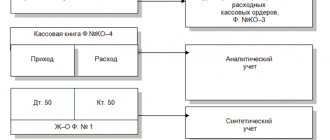The concept of targeted financing
Targeted financing is the allocation of funds for the implementation of strictly defined goals with the ability to control expenses. It could be:
- conducting scientific research;
- capital construction;
- organization of events;
- development of a new line of activity, etc.
According to the sources of funds received, financing is distinguished:
at the expense of the budget (state):
- subsidies - for example, to compensate for housing and communal services costs;
- transfers – for the construction of capital construction projects;
- grants – for carrying out research work.
at the expense of non-governmental organizations:
- scholarships;
- grants;
- investments.
If the financing conditions are met, the funds received become their own, otherwise they will have to be returned, “getting into” accounts payable.
Regulatory regulation
Accounting activities for targeted financing are carried out in accordance with the following legislative norms, features and documents:
- instructions on the procedure for determining the amount by which payments exceed the norm;
- instructions that include the procedure for transferring and reflecting money that was allocated from the federal fund;
- clarification related to the intricacies of accounting for assistance provided by individual entrepreneurs and legal entities;
- instructions describing the procedure for accounting measures during construction work;
- other documents providing regulation of the use of CS of innovation and other funds.
Maintaining analytical accounting for this account in accordance with the norms of current legislation is carried out according to the purpose of resources and according to the sources of their formation.
Postings to reflect target financing on account 86
In general, accounting entries for account 86 in commercial organizations look like this:
- Dt76 – Kt86 – reflects the receipt of targeted funds;
- Dt86 – Kt98 – target money is reflected as prospective income;
- Dt60 – Kt51 – payment has been made to the supplier for materials or goods;
- Dt10 – Kt60 – materials or goods delivered to the receipt;
- Dt20 – Kt10 – materials are written off;
- Dt91 – Kt20 – expense account is closed;
- Dt98 – Kt91 – targeted funds are reflected in the line of other income.
Records of the movement of received amounts depend on the nature of the activity of the economic entity. Thus, non-profit organizations can directly reflect the receipt of materials by posting Dt86 - Kt20 .
Accounting for receipt and write-off of target funds using examples
For a detailed examination of various operations using target revenues, we use illustrative examples of typical situations.
Receiving government subsidies
JSC “Minister” operates in the field of real estate construction. In March 2021, “Minister” took part in a tender to receive government subventions for their subsequent use for the construction of social housing. The amount of state aid is 3,478,000 rubles.
In April 2021, upon completion of the tender, JSC “Minister” was declared the winner, and therefore funds in the amount of 3,478,000 rubles were credited to the organization’s current account. In addition, the Minister received construction materials in the form of state aid, the cost of which amounted to 1,714,200 rubles.
The received government subventions were taken into account by the “Minister” in the following way:
| Debit | Credit | Operation description | Sum | A document base |
| 76 Targeted financing funds | 86 | The amount of funds accrued as government subventions is reflected (RUB 3,478,000 + RUB 1,714,200) | 5,192,200 rub. | Targeted financing agreement |
| 51 | 76 Targeted financing funds | The funds received by the “Minister” as a state target program are taken into account | RUB 3,478,000 | Bank statement |
| 10 | 76 Targeted financing funds | Materials received by the “Minister” for use in the construction of social housing were taken into account | 1,714,200 rub.) | Bank statement |
Reimbursement by the state for lost income
As part of the state program, JSC “Canteen No. 1” provides social food distributions to preferential categories of the population. The cost of rations issued to Canteen No. 1 in November 2015 is 412,850 rubles. This amount is fully compensated from the state budget.
The accountant of Canteen No. 1 made the following entries in the accounting records:
| Debit | Credit | Operation description | Sum | A document base |
| 51 | 76 Targeted financing funds | Funds have been transferred from the budget within the framework of the state program for assistance to social categories of citizens. | RUR 412,850 | Bank statement |
| 76 Targeted financing funds | 90.1 | Reflects compensation for revenue lost to Canteen No. 1 in connection with the issuance of food rations | RUR 412,850 | Agreement |
Investment of targeted proceeds in non-current assets
Progress JSC is engaged in the production of medical equipment. An agreement was concluded between JSC Progress and the charitable organization Mecenat, according to which:
- “Progress” receives funds from “Maecenas” in the amount of 1,953,500 rubles;
- the funds should be used to purchase an improved conveyor line, which will increase the production of medical equipment.
In September 2015, funds were received from Maecenas, the conveyor line was purchased and put into operation:
- cost of the conveyor line - 1,953,500 rubles;
- useful life – 12 years;
- the amount of monthly depreciation is 12,522 rubles. (RUB 1,953,500 / 13 years / 12 months).
The receipt of funds from “Maecenas”, the acquisition and commissioning of the conveyor line were recorded in the accounting records of “Progress” with the following entries:
| Debit | Credit | Operation description | Sum | A document base |
| 76 Targeted financing funds | 86 | The amount of accrued funds is reflected as received under an agreement with BO “Mecenat” | 1,953,500 rub. | Agreement |
| 51 | 76 Targeted financing funds | Targeted funds received from the charity “Mecenat” are taken into account | 1,953,500 rub. | Bank statement |
| 08 | 60 | The receipt of the purchased conveyor is reflected | 1,953,500 rub. | Packing list |
| 01 | 08 | The operation to put the conveyor into operation was carried out | 1,953,500 rub. | OS commissioning certificate |
| 86 | 98 | The intended use of funds received from the charitable organization “Mecenat” is reflected | 1,953,500 rub. | Agreement, Consignment note, OS commissioning certificate |
| 20 | 02 | The amount of monthly accrued depreciation on the conveyor is taken into account | RUB 12,522 | Depreciation statement |
| 98 | 91.1 | Other income is taken into account from the amount of deferred income (in the amount of accrued depreciation) | RUB 12,522 | Depreciation statement |
Use of targeted funds for current needs
JSC “Consul”, under a targeted financing agreement, transferred funds to LLC “Zoo” in the amount of 642,300 rubles. Funds have been provided for the repair of animal enclosures. Using the funds received from the Consul, the Zoo purchased the materials necessary to repair the enclosures. The actual repairs were carried out by the Zoo’s own staff.
The following transactions are recorded in the Zoo’s accounting records:
| Debit | Credit | Operation description | Sum | A document base |
| 76 Targeted financing funds | 86 | Reflects the amount of accrued funds on account of receipt under the agreement with JSC “Consul” | 642,300 rub. | Agreement |
| 51 | 76 Targeted financing funds | Targeted funds received from JSC “Consul” are taken into account | 642,300 rub. | Bank statement |
| 10 | 60 | The Zoo warehouse received materials purchased for the repair of animal enclosures | 642,300 rub. | Packing list |
| 86 | 98 | Materials purchased for repairs are accounted for as deferred income | 642,300 rub. | Packing list |
| 20 | 10 | The fact of using materials in the repair of animal enclosures is reflected | 642,300 rub. | Packing list |
| 98 | 91.1 | Other income from the amount of deferred income is taken into account | 642,300 rub. | Agreement, Consignment note |
What does the balance show and how is account 86 closed?
The credit part of account 86 displays the amount of funds allocated to the company under the terms of targeted financing. Its debit part reflects the unused balance, which will be spent in the future or returned to the investor.
In a standard situation, when the funds received under the contract were spent on the implementation of contractual goals in full, no additional entries are required to close the account. If the funds remain, then the accountant will have to reflect their further movement:
- if the balance can be used by the company at its own discretion, then posting Dt86 - Kt90 (sales) or Dt86 - Kt91 (other income) will be required;
- if the balance must be returned to the “sponsor”, then the posting looks different - Dt86 - Kt51 (non-cash payment), Dt86 - Kt50 (cash payment), Dt86 - Kt52 (payments in foreign currency).
When to use this account
Account 86 in accounting is intended to summarize information related to the movement of funds.
It is needed to carry out targeted activities based on amounts received from other organizations, individuals, and the federal budget. Monetary resources of a targeted nature, which were acquired in the form of sources of financing, are reflected in Kt 86. Correspondence to this direction is Dt 76, which reflects settlement transactions with creditors and debtors.
After carrying out analytical activities, you can notice that in practice this line can correspond by debit with the following accounts:
- 20 - main production part;
- 26 — expenditure areas of general economic importance;
- 83 - additional capital;
- 98 - future income receipts.
For a loan, this account can be used in conjunction with the following areas:
- 07 - materials with equipment for installation;
- 08 - deposits in non-circulating funds;
- 10 - materials;
- 11 - fattening animals;
- 20 - main production;
- 41 — commodity items;
- 50 - cash register;
- 51 - accounts of calculated value;
- 55 - special accounts in banking structures;
- 76 - settlements for receivables and payables.
Closing procedure
In the process of receiving and wasting financial assistance, there is a possibility that a situation may arise where the recipient spends less than the amount allocated by the “sponsor.” If, on the basis of the concluded agreement, this amount remains with the recipient, then the following entry must be made in the accounting records: Dt 86 Kt 90-1 (91-1).
The posting reflects savings on the part of the recipient. If the agreement provides for final settlement actions between the investor and the recipient on the basis of actual costs, in this situation the saved amount goes to the investor. In this situation, it is necessary to record the following entry: Dt 86 Kt 51 (50, 52). It means that the money saved was transferred to the investor's account.
What it is
This type of material support refers to the gratuitous receipt of financial resources and other instruments that must be used in accordance with the purpose pursued by the person who provided it. That is, it turns out that the expenditure of this type of funds is limited by certain conditions
.
If they are carried out correctly, the received instruments will go to the section of your own; if this is not done, you will have to return them and “get into” accounts payable. The list of these material resources includes the following elements and areas
:
- assistance from the state;
- subsidies from legal entities and individuals;
- non-repayable loans;
- sponsoring events.
These are direct economic actions aimed at increasing the benefits of the organization. They are presented in the form of subsidies, subventions, assistance and support in all directions. There are several goals
, for the achievement of which targeted financing funds can be used:
- expense or coverage of unprofitable areas;
- maintaining an optimal financial position;
- replenishment of balance funds;
- acquisition of assets.
Cannot be reflected
financing the following plan:
- receiving assistance in the form of benefits, including tax breaks, exemptions and holidays;
- credit funds or other repayable obligations;
- state capital and participation.
There are two key conditions
, in which a detailed reflection of target financing occurs:
- the need for a sufficient level of confidence and probability in achieving the target distribution of funds;
- confidence that help will be 100% received.
Where in the balance sheet and its explanations do non-profit organizations reflect fixed assets?
In the Balance Sheet, the value of fixed assets of non-profit organizations is reflected in section 1 in the line “Fixed Assets”. This must be done at the full original cost. Do not reduce it by the amount of wear.
In the explanations to the Balance Sheet, the value of fixed assets of non-profit organizations is reflected in Section 2 “Fixed Assets”, Table 2.1 “Availability and Movement of Fixed Assets”. However, in this NPO table, the columns “Accumulated depreciation” and “Accrued depreciation” are renamed “Accumulated depreciation” and “Accrued depreciation”, respectively. That is, unlike the balance sheet, the table shows both the full original cost and accrued depreciation.
This is stated in Note 6 to Appendix 3 to Order No. 66n of the Ministry of Finance of Russia dated July 2, 2010.
How much do they give?
The rules for receiving subsidies from the federal budget for SMEs affected by coronavirus were approved by Decree of the Government of the Russian Federation of April 24, 2021 No. 576.
The amount of the subsidy depends on the federal minimum wage as of January 1, 2021, amounting to 12,130 rubles, and the number of employees from reports on the form SZV-M for March 2021
For individual entrepreneurs with employees, the number of employees for March increases by one. For individual entrepreneurs without employees, the subsidy is equal to one minimum wage, that is, 12,130 rubles.
The subsidy can be spent on paying salaries for April and May 2020, as well as on other needs related to production activities during the crisis.
What are the subaccounts?
An important role is played by the main sub-accounts of the account in question, which are also taken into account in the process of compiling certain transactions. In total, there are two key subaccounts on this line:
- 86-1 – targeted financing of funds from the organization’s budget fund;
- 86-2 – other areas of financing and revenue.
Both of these accounts are relevant and widely used in practice, so accountants often use them to display a large number of activities.
How non-profit organizations account for fixed assets
The conditions under which non-profit organizations accept fixed assets for accounting differ from the rules for commercial structures. Here are the criteria for a fixed asset for non-profit organizations:
- period of use of the object – more than 12 months;
- the organization does not plan to sell the property;
- the object is intended for the statutory, entrepreneurial activities of the organization or for its management needs.
Such conditions are written in paragraph 4 of PBU 6/01.
If an NPO has acquired or received free of charge (as a gift) an object that is intended for transfer to third parties, it is not included as a fixed asset. These assets are taken into account as part of materials.
Accounting entries for the receipt of fixed assets will vary depending on how they were received: for a fee or free of charge.
simplified tax system
Acquisition costs
Expenses for the acquisition of fixed assets received free of charge or at the expense of earmarked funds for statutory activities cannot be recognized as expenses under the simplified procedure. This conclusion follows from paragraph 4 of Article 346.16, paragraph 1 and subparagraph 2 of paragraph 2 of Article 256 of the Tax Code of the Russian Federation.
Income and expenses upon sale
When calculating the single tax, an NPO includes in its income the full sales value of the fixed asset. And even if you use a simplification with the “income minus expenses” object, do not take into account the initial cost of the fixed asset in expenses. Since targeted funds are not taken into account in income, then costs at their expense are not taken into account either. In addition, the organization had no intention of using such property for the purpose of generating income. And generating income is one of the conditions to write off as expenses for the acquisition of an object.
This conclusion follows from paragraphs 1 and 4 of Article 346.16, subparagraph 1 of paragraph 1.1 of Article 346.15, paragraph 1 of Article 252, Article 250, paragraph 2 of Article 251 of the Tax Code of the Russian Federation and letter of the Ministry of Finance of Russia dated February 5, 2010 No. 03-03-06/ 4/9.
BASIC
Is it possible to calculate depreciation in tax accounting?
Non-profit organizations that received fixed assets free of charge or purchased them using earmarked funds and use them in their statutory activities do not accrue depreciation on them. This is directly stated in subparagraph 2 of paragraph 2 of Article 256 of the Tax Code of the Russian Federation.
How to determine sales proceeds
When calculating income tax, determine the proceeds from the sale of a fixed asset of an NPO as its full sales price excluding VAT. It cannot be reduced for the cost of purchasing the property. Since targeted funds are not taken into account in income, then costs at their expense are not taken into account either. In addition, the organization had no intention of using such property for the purpose of generating income. And generating income is one of the conditions to write off as expenses for the acquisition of an object.
This conclusion follows from paragraph 1 of Article 252, paragraph 2 of Article 251, Article 250 of the Tax Code of the Russian Federation and letter of the Ministry of Finance of Russia dated February 5, 2010 No. 03-03-06/4/9.
How to calculate VAT on the sale of fixed assets
For non-commercial organizations, there are two options for calculating VAT on the sale of fixed assets.
First option : VAT must be charged on the full sales price (clause 1 of Article 154 of the Tax Code of the Russian Federation). Do this if VAT was not paid upon receipt of the fixed asset. For example, they received it for free or purchased it from an organization on a simplified basis.
Second option : charge VAT on the difference between the sale and residual value of the property. That is, according to the rules of paragraph 3 of Article 154 of the Tax Code of the Russian Federation. Using these rules, determine the tax base when the fixed asset was purchased with VAT, but the tax was not deducted. For example, the object was used for statutory activities or in business activities exempt from VAT. For full details on how to do this and examples, see How to calculate VAT on the sale of property accounted for with input VAT.





